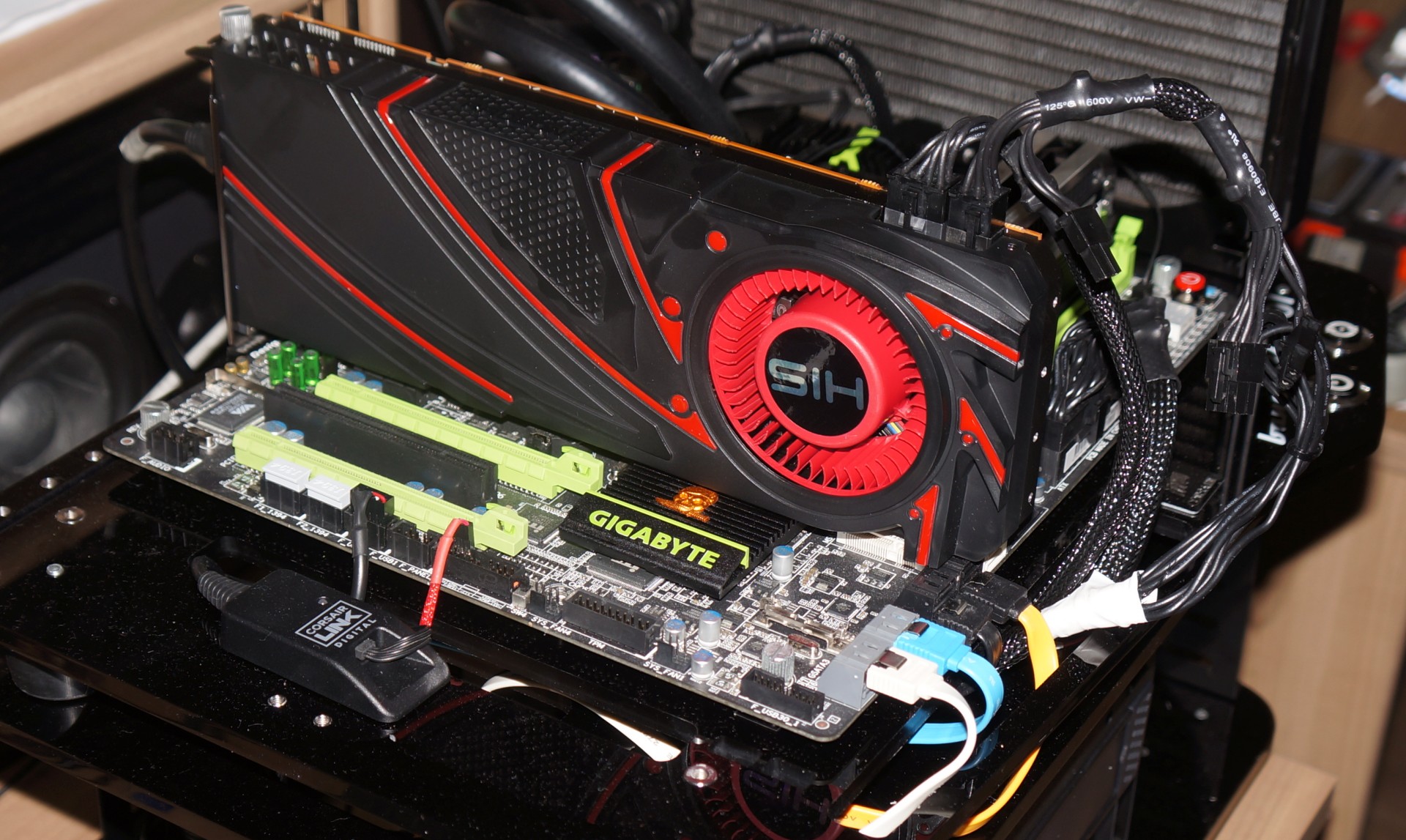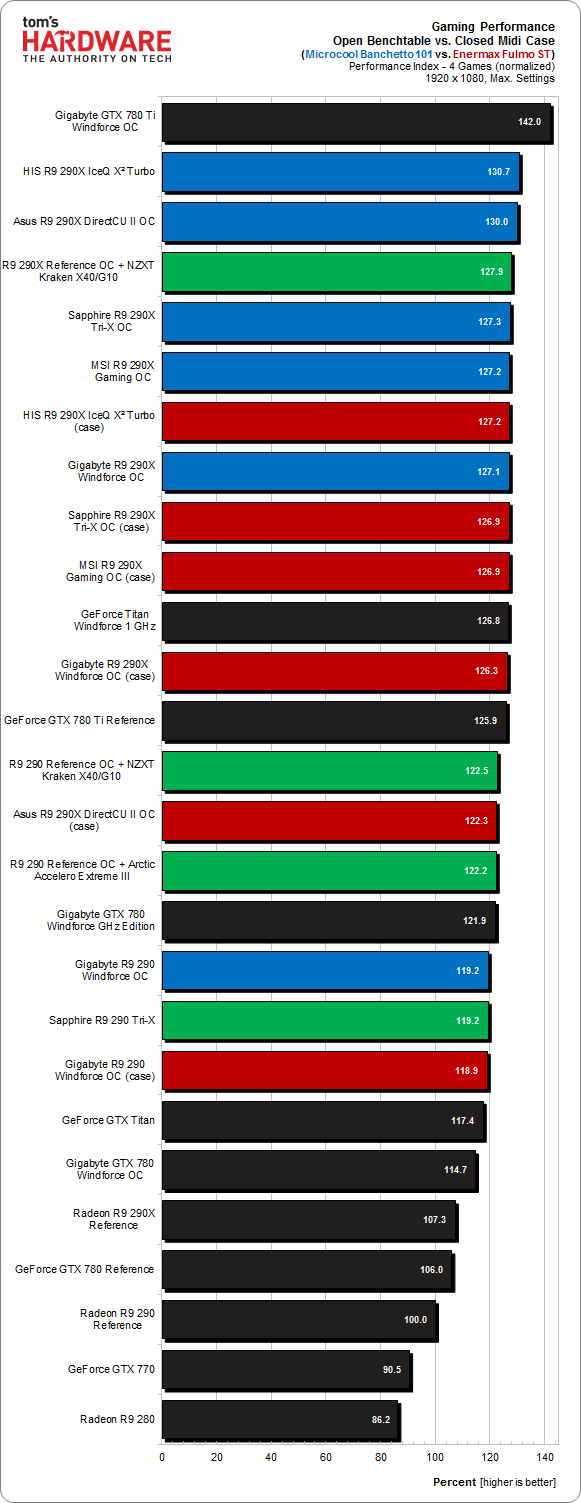Partner Cards: Two Radeon R9 290s And Five 290Xs, Updated
Gaming Performance
Benchmark System and Software
When I wrote Seven Radeon R9 280X Graphics Cards, Rounded-Up, I made the assumption that most of our readers would know that gaming performance would correlate to clock rates, and focused most of my efforts on power, heat, and noise. We heard the feedback from that piece, though, and incorporated benchmark results into today's story.
I ran four carefully-selected titles at their highest quality settings, and then normalized and added the results. This yielded a performance index with AMD's Radeon R9 290 reference card serving as the 100-percent baseline.
| CPU And Cooler | Intel Core i7-3770K (Ivy Bridge) at 4.5 GHz Corsair H100i Compact Water Cooler (Gelid GC Extreme) |
|---|---|
| Motherboard | Gigabyte G1. Sniper 3 (Z77 Express) |
| Memory | 32 GB (4 x 8 GB) Corsair Dominator Platinum DDR3-2133 |
| SSD | 2 x Corsair Neutron 480 GB |
| Power Supply | Corsair AX1200i |
| Operating System | Windows 7 x64 Ultimate SP1 |
| Drivers | AMD Catalyst 13.12GeForce 331.82 |
| Benchmarks | Metro: Last LightBioShock InfiniteBattlefield 4 (Single-Player)Crysis 3 (DirectX 11) |
We warmed up each graphics card until it reached its peak temperature, keeping us as close as possible to real-world performance and to prevent unfair advantages for either AMD or Nvidia due to artificially high boost speeds. The cards were tested on an open bench table (blue bars) and in a closed mid-tower (red bars).
Get Tom's Hardware's best news and in-depth reviews, straight to your inbox.

Igor Wallossek wrote a wide variety of hardware articles for Tom's Hardware, with a strong focus on technical analysis and in-depth reviews. His contributions have spanned a broad spectrum of PC components, including GPUs, CPUs, workstations, and PC builds. His insightful articles provide readers with detailed knowledge to make informed decisions in the ever-evolving tech landscape
-
yannigr You can write as many articles as you want about 290/290X coolers. You can write as many excuses as you want. You can continue reminding us that there was/is a problem with Hawaii every 15 days for the whole 2014. That "victory dance" that "excitement" that you found(?) AMD cheating(?) back then, all that rage against AMD, can not be unwritten.Reply -
FormatC Replyall that rage against AMD
I would like to know this more precisely please... I can't found any rage in my articles, only a chip with a very high temperature density and a lot of unusable coolers because the engineers were not able to build a matching cooler for this cards. This high density will be a global problem for all next-gen chips too. Without a vapor chamber this won't work. -
outlw6669 Good job on the review Tom's German team and great work from AMD's partners!Reply
Coupled with other recent reviews, Sapphire's Tri-X OC series looks to be great cards, especially when you make a custom fan curve to further reduce idle and load noise.
I can not wait to see the 20nm updates, especially if AMD gets around to pulling a Titan with their reference coolers! -
FormatC I will add in the next days more cards like Gigabyte's R9 290 (without X), the MSI R9 290X and something other (secret) :)Reply -
rdc85 I think this card is made/means to be WC -ed..... 290 in Kraken looks promising.. (trying imagine how good if in full water block, good radiator)Reply -
roymustang The main problem with the 290 and 290X isn't the cooling, it's the fact that bitcoin and litecoin miners have driven the price of these cards up by $100-150; to the point where they are no longer a good deal at all.I was waiting for the custom cooled 290s to come out to upgrade my GTX 670 but now I may just wait for the next cards and maybe stick with nVidia.Reply -
Phillip Wager i want so badly the 290 to go back to 400 bucks cuz that is like my hard limit on a video card ive been waiting but i don't think i can wait much longer and i guess i'll just get a 770. i'm even willing to put up with the reference coolers bah.Reply -
patrick47018 "You can see this in the image below, where two of the heat pipes don't **tough** Hawaii at all, and two others make partial contact. " Spelling mistake, on topic I like the Sapphire Toxic's design and performance.Reply

